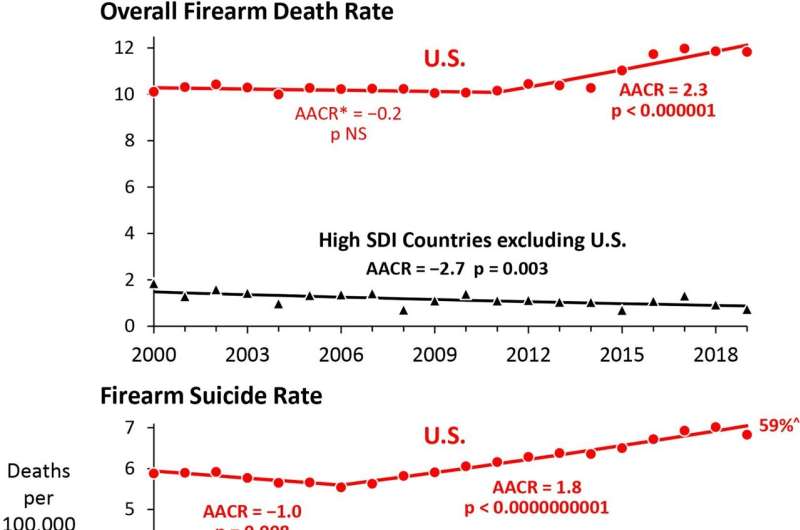
Joinpoint/AAPC* analysis of annual total firearm mortality, homicide, and suicide rates, 2000–2019, US and other high SDI countries. Source: PLOS ONE (2024). DOI: 10.1371/journal.pone.0290138
Archie Bleyer, MD, remembers the day his research focus shifted. His 12-year-old grandson’s classmate and soccer teammate was killed by a gun. He knew the boy’s mother and said her son “left a note and used the gun, but he didn’t have to die because he was having a bad day.”
In another case, the patient woke up to hear his son committing suicide with a gun.
These events changed Bleyer’s life.
Bleyer is a clinical research professor at OHSU’s Knight Cancer Institute. He has been a pediatric oncologist since 1971, focusing on the prevention and treatment of cancer in the adolescent young adult population, ages 15 to 39. He continues to do cancer research, but in the past decade his attention has focused on a disturbing trend: More young people are now dying from gunfire than from cancer. And the numbers are rising.
Bleyer is lead author of a recent study in the diary PLOS ONE study of mental disorders and firearms data from 2000 to 2019. Using data from the Institute for Health Metrics and Evaluation Global Health Burden, the researchers compared the United States to 40 countries with similar sociodemographic profiles. They found that while the prevalence of mental disorders in the United States is comparable to that of 40 similar sociodemographic countries across all major categories, the rate of firearm deaths is 20 times higher.
“We have the same rate of mental health problems as other countries, but our firearm mortality rate is much higher and continues to rise,” Bleyer said. “In most countries, firearm mortality is declining.”
Since 2000, the total number of firearm deaths has increased by 23%. In the other 40 countries combined in the study, firearm deaths have decreased by 27% over the same period.
“In all other countries, firearm deaths declined despite similar rates of mental disorders,” Bleyer said.
Bleyer has been invited by Texas Doctors Working to End Gun Violence to present the research findings at the Texas State Capitol on Friday, September 27.
Bleyer said it’s important to note that this study does not undermine the mental health crisis in the U.S.
“We have really significant mental health issues, there’s no doubt about it,” he said. “We don’t have enough mental health providers, facilities, treatments. It’s the way we’ve facilitated suicide that leads to death by firearm, where we’re taking it to the extreme.”
Bleyer said polls show that most of the public, as well as leaders of both major political parties, believe that mental illness is the cause of America’s high gun death rate. His research shows another correlation: Gun suicides have increased 18 percent over the past decade, and gun homicides have increased 39 percent since 2000. In all 40 countries in the study, those same rates have declined despite similar, or in some cases higher, rates of mental illness.
The difference is simply the guns. The U.S. has 4 percent of the world’s population, but nearly 25 percent, or one in four, of the world’s firearms—and half of the nonmilitary assault weapons—are in American homes. Bleyer said that percentage is growing.
“Gun deaths are a public health crisis in the United States,” Bleyer said. “The prevalence of mental illness does not explain the higher number of gun deaths. The difference is that in this country we have a way of taking those mental illnesses to the extreme by using guns, which leads to death.”
More information:
Archie Bleyer et al., Misconception about Attributing the US Epidemic of Gun Deaths to Mental Health, PLOS ONE (2024). DOI: 10.1371/journal.pone.0290138
Quote: US gun prevalence creating public health crisis of gun deaths, study finds (2024, September 9) retrieved September 10, 2024 from https://medicalxpress.com/news/2024-09-prevalence-firearms-health-crisis-gun.html
This document is subject to copyright. Except for fair dealing for private study or research, no part may be reproduced without written permission. The contents are supplied for information purposes only.
 Healthy Famz Healthy Family News essential tips for a healthy family. Explore practical advice to keep your family happy and healthy.
Healthy Famz Healthy Family News essential tips for a healthy family. Explore practical advice to keep your family happy and healthy.


